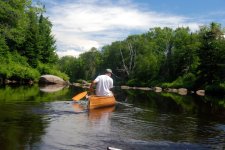Hi folks! So, I've determined that I don't have enough paddles. Also, I'm too cheap to buy one, so I figure I'll take a crack at making a couple. I'll model them off my current grey owl paddles and laminate some wood scraps together that I have and basically see what happens! A bit of trial and error for my first ones. Anyway, I have a couple questions that I could probably find the answer to if I searched online (but I thought this way would be more fun):
What material can I use for the 'wear strip' at the bottom of the blade?
So that's only one question. I'll hold my other question in reserve
What material can I use for the 'wear strip' at the bottom of the blade?
So that's only one question. I'll hold my other question in reserve

